Hard stones forever
Permanent ornamentation. The use of hard stones in diplomacy, magnificence and commerce
Is there a more beautiful, ornamental, magnificent and colourful substance to be used in furnishing than hard stone?
Hard stone table top, made for the Elector Max I Emanuel of Bavaria, after 1623 when the Electoral dignity was conferred on Bavaria.
Since antiquity, hard (and soft) stones - often called by their Italian name pietre dure and pietre tenere - were employed as highly decorative and beautiful adornments to buildings and their adjuncts, furniture. Great medieval examples include the small pieces of stone (including green serpentine and purple porphyry) used in the Cosmat-esque medieval pavement in Westminster Abbey (see previous post); the interior of St Mark’s Basilica in Venice is covered in hard stone. Most churches - in particular altar fronts and floors - in Rome and throughout Italy make clever decorative use of rich marbles. One of my personal favourites is Santa Maria in Trastevere, where classical Roman hard stone columns are re-used in a medieval Christian basilica.
Interior of Santa Maria in Trastevere, showing hard stones used in the floor and re-used ancient columns (picture by Sailko, CC BY 3.0)
Not only were stones capable of taking a high polish to show a range of subtle colours, gradations, textures, but they were also deployed in buildings and interiors for practical, political and decorative reasons. In practical terms stone is extremely durable and its decorative arrangement (known in Italian as ‘commesso’) effectively a permanent creation. The political angle of hard stone, usually a luxury item, allowed a patron to show off his or her splendour and wealth through elaborate combinations of stones. In decorative terms, hard stone arrangements (commessi) were often formed into panels and added to a piece of furniture to add colour and richness, or additional elaboration in an interior or exterior scheme. A fascinating new book by Fabio Barry, Painting in Stone (Yale, 2020) takes as its central thesis, the language of marbles as used in architecture from antiquity down to the eighteenth century. I have not read it yet, but Prof Barry seems to me to be the first person to suggest that specific marble choices for building materials and wall decorations in buildings were done not solely for ‘mere decoration’ or to show one’s power, wealth and status - the standard Marxist interpretation of luxury objects. He looks to understand why specific marbles were used in specific settings. For instance, he suggests that the white marble used in antiquity is associated with radiance, and points out that the Greek word leukos is often translated as ‘white’ but in fact signifies radiance; and from leukos comes the Latin lucere (to shine) and from the Latin the European language words including luce, luz, licht, light etc. Unsurprisingly, I am attracted to an explanation for what we might dismiss patronisingly as mere decoration.
Hard stones played a part in diplomacy: having developed a hard stone manufactory in Florence - the ‘Galleria dei Lavori’ caskets veneered with hard stone pictorial panels were given as ‘state’ gifts by the Grand Dukes of Tuscany to build a foundation of goodwill between states, show native skill and possibly invite commissions, encouraging trade and developing fashion abroad.
Chest presented to Oliver Cromwell as a diplomatic gift on behalf of Ferdinand de Medici, Grand Duke of Tuscany, in 1656 (© The Cromwell Museum)
Commerce also played its part. The business of developing these luxurious and desirable works played to the aspirations of wealthy patrons, who sought to own works in hard stone. Following Florence’s lead in the late 16th and 17th centuries, major centres of hard stone working - lapidary manufactories - were also established in Rome, Naples, Madrid, Paris and Prague.
Such was the brilliance of hard stone as a medium, its endurance / permanance and its ability to be organised into patterns - pictorial, abstract, geometric, mathematical, natural - which could suggest or imply knowledge of the world through the clever use of panels depicting various motifs. These cabinets, in a small way, reflect the intentions of assembling and classifying objects in the way museums and collections have done since the 16th century (the earliest surviving collection organised formally in this way being Archduke Ferdinand of Austria’s kunstkammer at Schloss Ambras, Innsbruck, Austria). Several cabinets probably made in Augsburg in the mid-17th century are fitted with Florentine plaques depicting unusual geometric designs - as well as more conventional plaques depicting flora and fauna - perhaps derived from 16th century goldsmith Wenzel Jamnitzer’s treatise on Platonic solids Perspectiva corporum regularium (1568).
Ebony and ivory cabinet, Augsburg c. 1650, with Florentine pietre dure plaques, Rosenborg Castle, Denmark (© Kongernes Samling/The Royal Danish Collection)
Not every patron thought in this way. Some - probably most - sought out pietre dure mounted objects as a suitably large and semi-public expression of their own wealth, and for the purpose of grand decoration perhaps. The most remarkable and probably the most famous example of this is the ‘Badminton’ Cabinet, a giant ebony-veneered cabinet-on-stand fitted with pietre dure plaques and gilt bronze statuettes, commissioned from the Galleria dei Lavori by the duke of Beaufort when in Florence during his Grand Tour of Italy and Europe. It was subsequently at Badminton House, Gloucestershire until its sale in 1990. This extremely large cabinet was no doubt intended as a none-too-subtle advertisement to his fellow English collectors for the duke’s cultural credentials as a patron of Italian contemporary art.
The Badminton Cabinet, at the Liechtenstein Palace, Vienna, with H.S.H. Prince Hans-Adam II von und zu Liechtenstein. (© LIECHTENSTEIN, The Princely Collections, Vaduz-Vienna)
In 1990 the great cabinet was sold to Barbara Piasecka Johnson and subsequently sold by her in 2004 ( https://www.christies.com/en/lot/lot-4420049 ) - both sales at Christie’s London when it was bought by H.S.H. Prince Hans-Adam II von und zu Liechtenstein (see: https://www.lgt.com/en/about-us/the-princely-collections) for £19m. The Princely family of Liechtenstein are renowned as great patrons and collectors, especially of 17th and 18th century works of art and paintings: the Badminton cabinet remains a signifier of wealth and joins an historic European collection already filled with great objects of a comparable quality and type.
Throughout the 18th century and 19th centuries Florence continued to produce great examples of pietre dure, but the high water mark of the 17th century had passed. The Galleria dei Lavori (on the ground floor of today’s Uffizi galleries) was relocated further north in Florence and renamed the ‘Opificio delle Pietre Dure’ (http://www.opificiodellepietredure.it/) , where it remains, and their museum collection traces the history of Florentine hard stone manufactory - and is well worth a visit, and is often uncrowded.
Museo dell’Opificio delle Pietre Dure, Florence (photos: Rufus Bird, 2015).
Cabinets - usually veneered in ebony or ivory and fitted with pictorial hard stone plaques were popular in the 17th century in the main centres of hard stone production of Florence, Rome and Paris - and also Augsburg where many cabinets were made. More widespread and popular were the famous table tops or slabs, also made in geometric, naturalistic or pictorial patterns. The best-known of these is probably the ‘Farnese’ table top in the Metropolitan Museum of Art, New York, but many others were bought and sold by great collectors in the 18th and 19th centuries (https://www.metmuseum.org/art/collection/search/202115).
The Farnese table top, Rome c.1565-1573 (The Metropolitan Museum of Art, New York, 58.57.a-d)
The ‘Borghese-Beckford’ table top, c. 1600, Rome. (Charlecote Park, Warwickshire ©National Trust Images/Andreas von Einsiedel)
William Beckford, a renowned collector of great works of art throughout the first half of the 19th century, owned several pietre dure table tops including this spectacular 16th century Roman example (with an alabaster oval in the centre) which was sold from Fonthill Abbey in 1823, after which it was brought to Charlecote Park, Warwickshire.
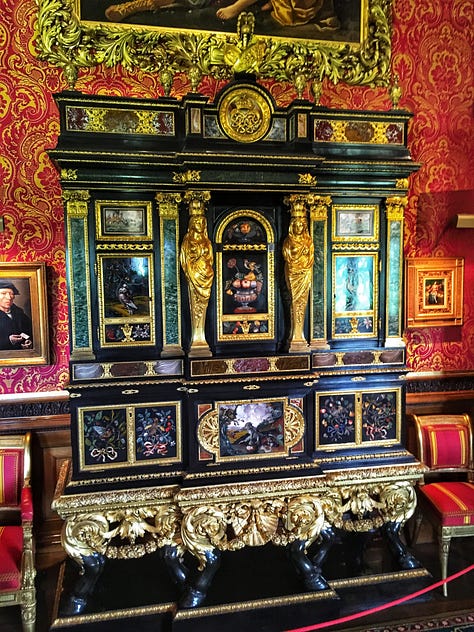


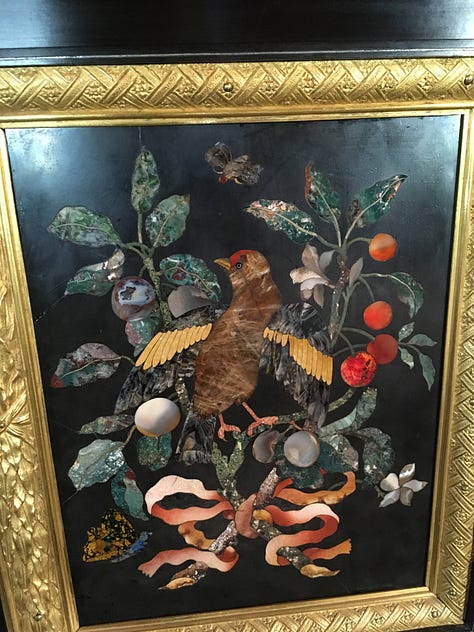
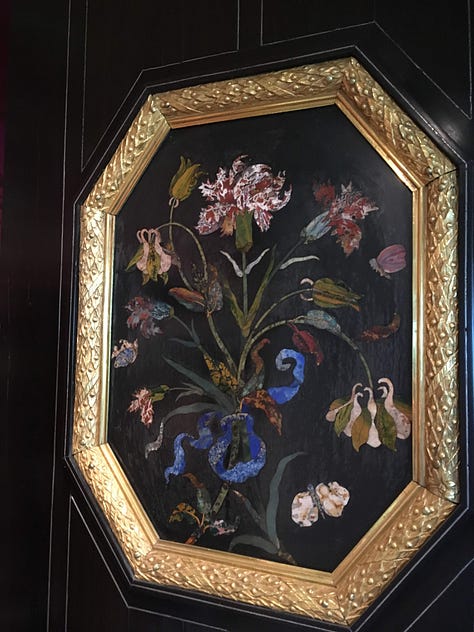
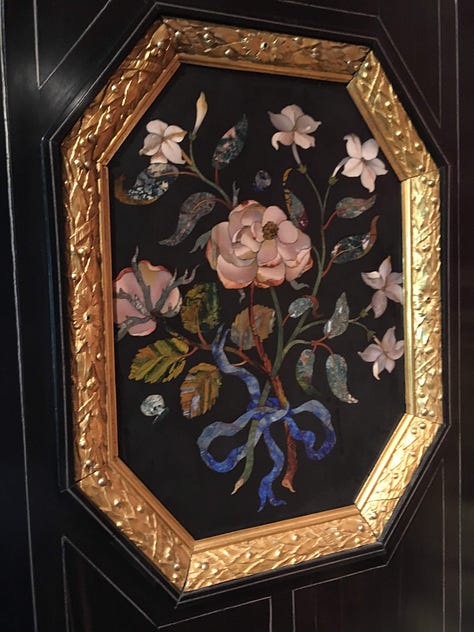
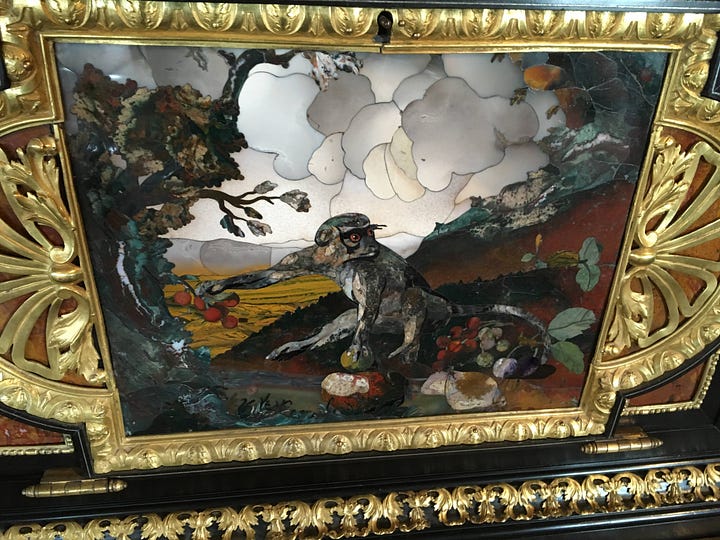

As a great European prince, Louis XIV understood the power of hard stones, purchasing a great collection of vessels known as the ‘gemmes de la couronne’ from Cardinal Mazarin, many of which remain in the French national collection at the Louvre and are very beautifully and appropriately shown in glass cases in the restored Galerie d’Apollon (Apollo Gallery). The king, under the guidance of his chief minister Colbert, established a national manufactory of all types of works of art, known as the Gobelins Manufactory, designed to furnish the French royal palaces with great objects made in France - often using immigrant craftsmen. Tapestries and other textiles, silver, furniture, and hard stones were all made there, including the spectacular pair of cabinets now at Alnwick Castle (see above), made for Louis XIV in 1683.
Some of the French crown jewels or ‘gemmes de la couronne’, collected by Louis XIV, Apollo Gallery, musee du Louvre, Paris (© RMN musee du Louvre 2022)
Hard stone working is not exclusively European: lapis lazuli is found only in Afghanistan and Russia, malachite and certain types of Russian porphyry are found in small areas of Russia. Further east still, the Mughal emperors in India had shown interest in European princely furnishings, including hard stones, from the 16th century. Mughal architecture included hard stone decorations both Indian and European, the most famous example is the remarkable scheme of hard stone decoration in the seat of the Mughal empire, the throne in the Hall of Public Audiences at the Red Fort in Delhi, completed in 1648. Here can be found three-hundred and eighteen Florentine pietre dure plaques, with a principal central plaque depicting Orpheus. It is known that the Florentines presented to Nawab Jafar Khan on 12 September 1665 ‘a board, with nineteen pieces to make a cabinet, the whole of precious stones of diverse colours representing all kinds of flowers and birds. The work had been done at Florence and had cost 2150 livres’ (Jean-Baptiste Tavernier, Travels in India).
Shah Jahan’s throne or jharoka, Hall of Public Audience in the ‘Red Fort’, Delhi, completed 1648. The arched panel in the back wall behind the canopied throne is inlaid with Florentine hard stone commessi di pietre dure perhaps that presented in 1665.
Hard stone objects continue to command attention among collectors today, inspired by great collections and collectors of the past. There is an international dimension to these objects, created to reflect the splendour of their origin - Florence, Rome or Paris in particular, but also other regional centres such as Prague, Munich, Madrid and Naples - reflected in the diplomatic function of certain objects. The often impressive scale of these pieces provided their patrons and also later owners with a way to show their power, status and wealth and usually all three. The durable, permanent quality of stone perhaps reflected the patron and subsequent owners’ own aspirations for some sort of permanence in collecting terms (ie not as an immortal being, but to be remembered as a collector). Prof Barry’s book (to be read) recommends we must understand marbles in a different way - beyond decoration. Notwithstanding his argument, the richness provided by the judicious arrangement of coloured marbles, alabasters and stones created a sumptuous two- and three-dimensional art form which resulted in a meaningful and appropriately rich (often luxury) object, as a suitable - often princely - ornament for a palace or church, which continues to appeal today.

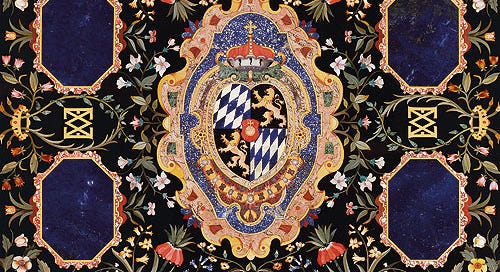




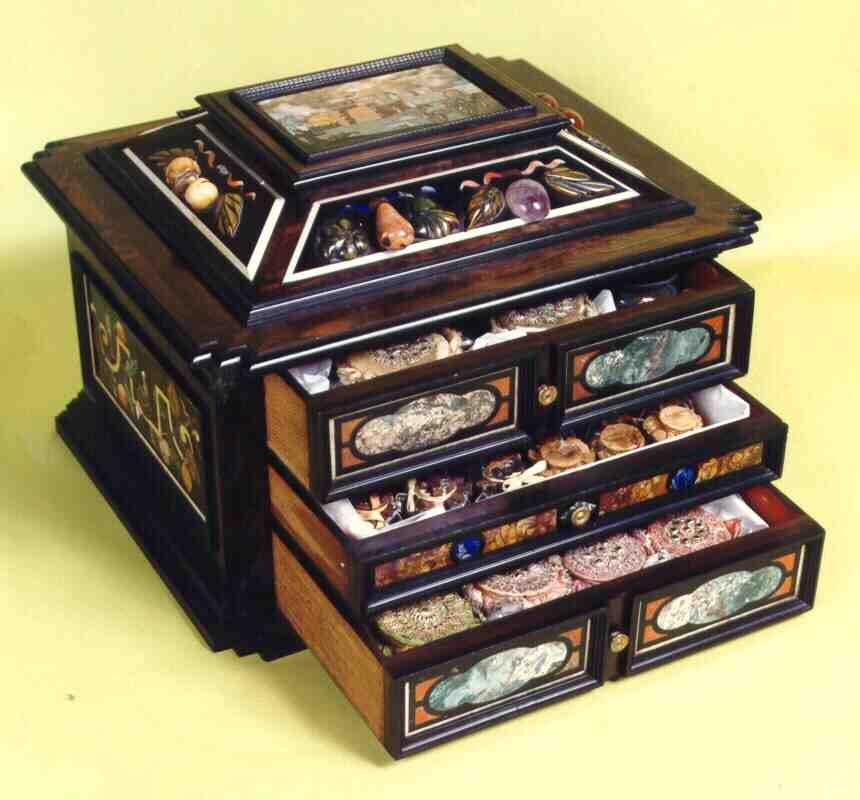

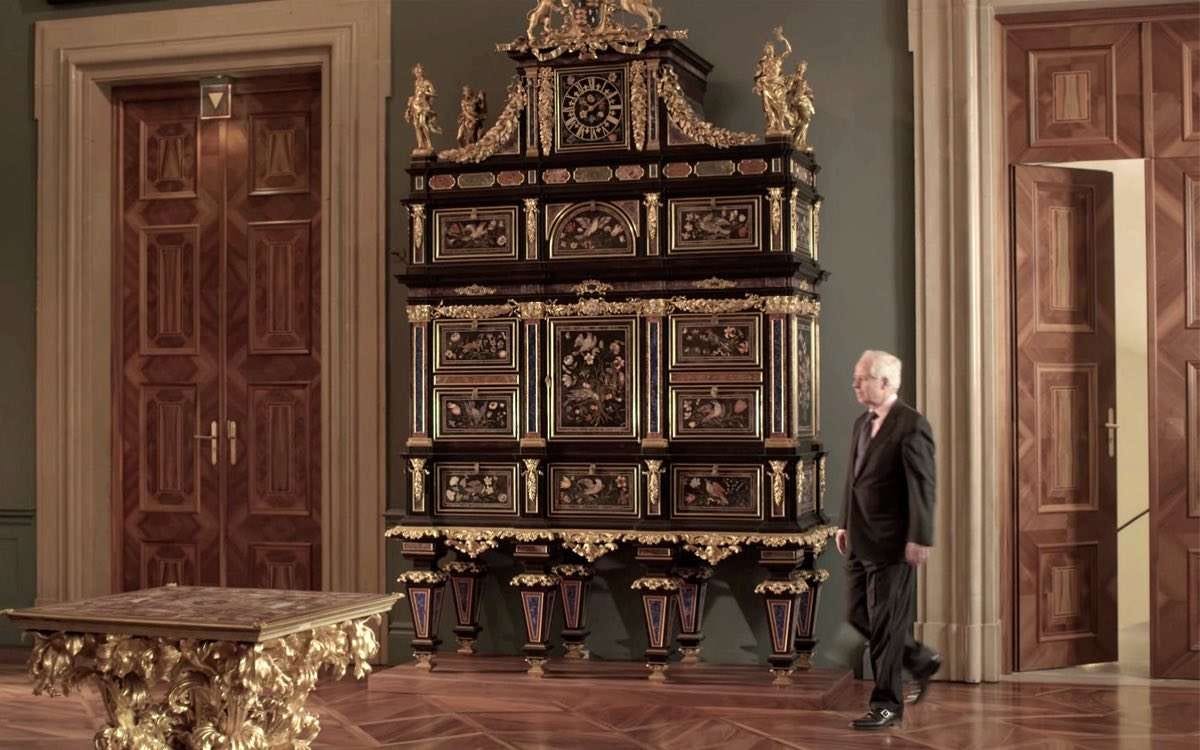
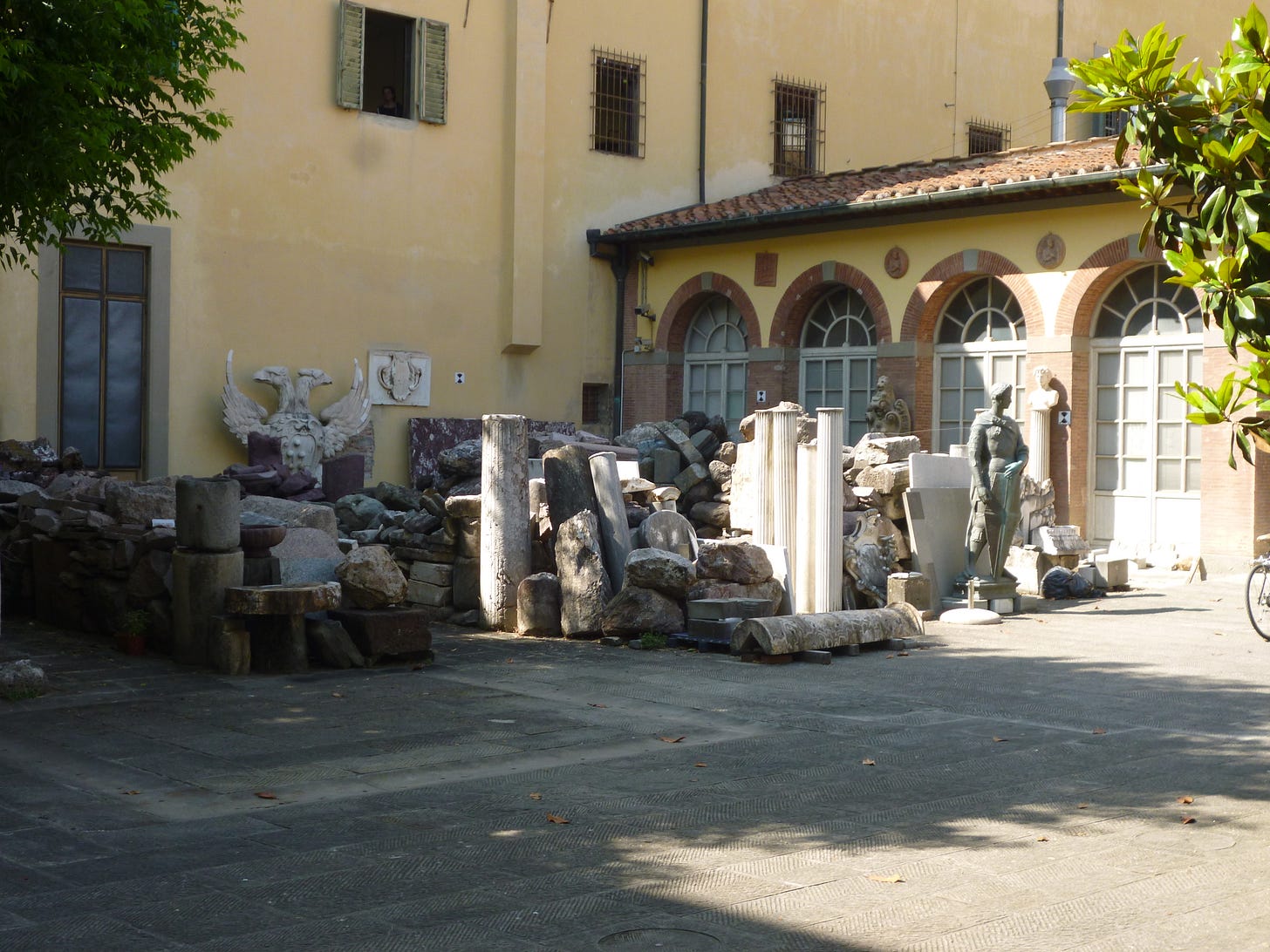

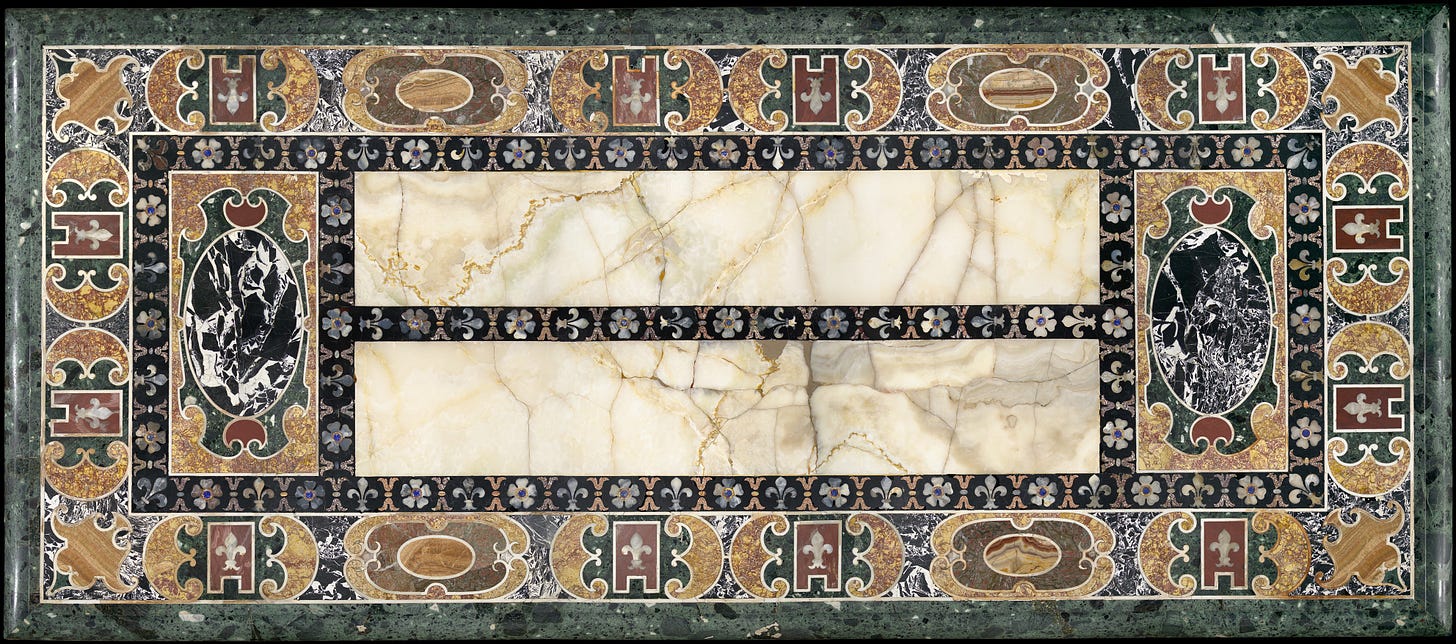



I find it odd that the taste for hard stone in France doesn't seem to have continued from Louis XIV's time to that of successors. I've only seen one Louis XV commode with a multi-coloured hard stone top.